
Greater Consideration of Animals Will Enhance Coastal Restoration Outcomes
- Posted by Alex White
- On August 15, 2023
The restoration of ecosystems that continue to be lost and degraded is a key challenge of the 21st century. Given the enormous effort and investment, it is critical that projects maximise benefits for biodiversity. Unfortunately, restoring coastal habitats is notoriously difficult. One likely, yet largely overlooked, impediment to effective restoration of coastal systems could be failing to explicitly consider non-habitat forming animals such as fish, bivalves, and crustaceans. These organisms perform important functions necessary for ecosystem persistence and resilience, and drive many of the services restoration seeks to enhance.
As part of an Australian Research Council (ARC) Discovery Early Career Researcher Award (DECRA), Dr Michael Sievers is leading a project on improving our understanding of how coastal restoration benefits animals and vice versa. The work ultimately aims to improve restoration outcomes, and has four general themes: (1) Progressing the theory of how animals can enhance restoration success; (2) Evaluating animal responses to global efforts to restore coastal systems; (3) Understanding the benefits of seascape connectivity and multi-habitat restoration, and; (4) Harnessing positive species interactions.
Progressing the theory of how animals can enhance restoration success
By Dr Michael Sievers
In our paper published in BioScience, we explain how knowledge of interactions between animals and restored coastal habitats could be better incorporated into restoration planning, implementation, and evaluations of success. Identifying when, why, and how to directly manipulate or support animals can enhance outcomes for habitat-forming species. We provide a conceptual framework to identify actions that could lead to better restoration outcomes, regardless of the ultimate restoration objective.
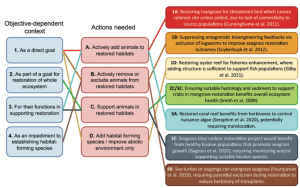
Four key contexts in which animals could be manipulated and supported within coastal restoration, the actions that can lead to positive outcomes.
Evaluating animal responses to global efforts to restore coastal systems
I have systematically reviewed the scientific literature and created a global database on animal responses to coastal restoration. A quantitative synthesis of animal research in restored coastal ecosystems can inform restoration and monitoring practice, help guide policy for conservation and identify research trends and gaps.
Despite high levels of variability and context-dependence in faunal responses to restoring coastal ecosystems, overall animals appear to be readily inhabiting restored coastal habitats. Restored sites were harbouring animal populations that were as or more abundant than control sites, communities that were as or more diverse, and individuals that were similar in condition. Interestingly, we did not find that animal populations or communities were affected by how long ago a habitat was restored, nor by the size of the restored habitat. Stay tuned for the publication.
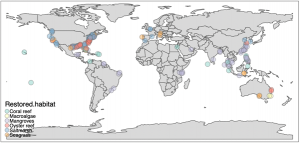
Study locations of restored sites where animal responses were monitored.
Understanding the benefits of seascape connectivity and multi-habitat restoration
Although potential for multi-habitat restoration and the benefits of considering the seascape are gaining traction, empirical examinations – particularly at scales relevant to most current restoration projects – of how these concepts affect fauna remain scarce. I recently worked at one of the world’s premier restoration locations to test these ideas. We surveyed fauna within 133 sites in Vejle fjord, Denmark. These point locations were within natural seagrass, on bare sand, and in restored seagrass that was transplanted 1, 2, 3, or 4 years ago. These sites also varied in terms of their distance to a nearby restored boulder reef and restored mussel beds.
A diverse faunal community, including fish, crustaceans and gastropods, colonised all restored patches – and at similar abundance to natural sites – despite very low seagrass density in newly restored areas. Results regarding both condition of animals and the effects of seascape connectivity are coming.
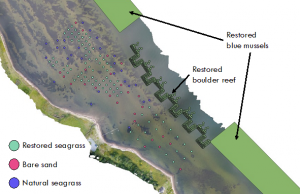
The 133 sites surveyed for fauna within Vejle fjord, Denmark.
Harnessing positive species interactions to benefit outcomes
Some experiments have shown how manipulating animals can benefit restored vegetation. For instance, translocating clams into restored seagrass can expand patch size, whilst adding mussels to plots with transplanted saltmarsh can similarly enhance plant growth and clonal expansion. In future work, I will be investigating how to improve restored seagrass success by manipulating fauna in an Australian context.


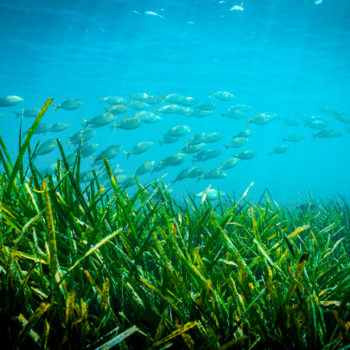
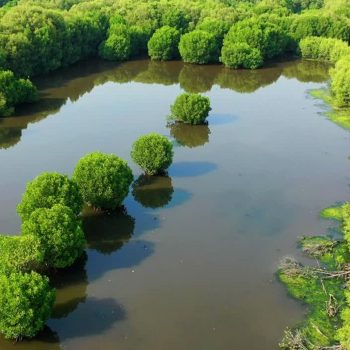
0 Comments